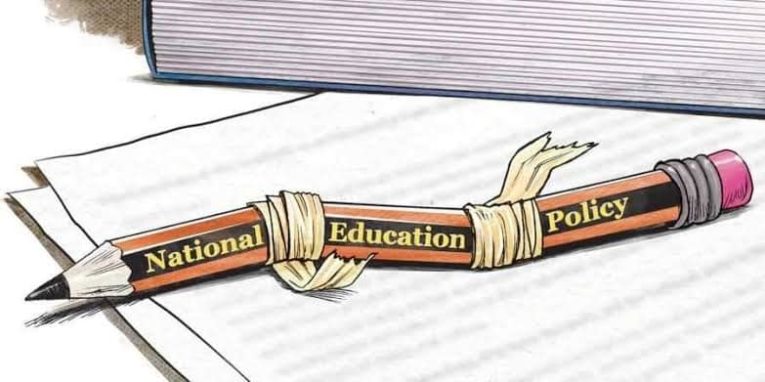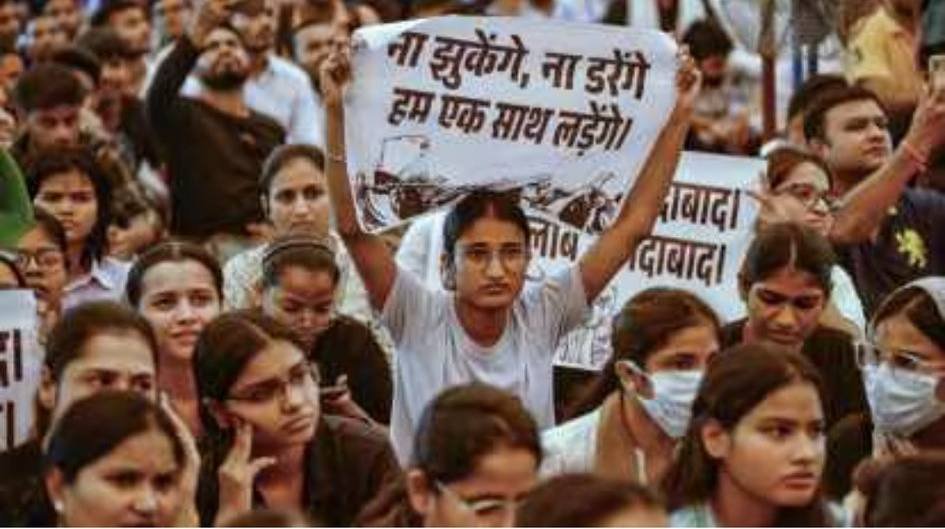New Education Policy (NEP) 2020: A Ploy to make education a privilege rather than right!
The Union Cabinet gave a green signal to the ‘New Education Policy 2020’ on 29th July, notwithstanding the widespread criticism and opposition from students, teachers and members of academia as well as intelligentsia. The NEP was basically supposed to be introduced as well as passed in both the houses of parliament, but the modus operandi of Modi Government, which is quite well-known to all by now, certainly puts that out of question. The NEP aims at cutbacks in government spending on education and paves the way for investment by big capital and consequently pushing a major student population coming from marginalised sections out of the academic arena. However voluminous the ‘New Education Policy’ document is, its sole purpose is to straddle the fence as far as state’s commitment to the field of education is concerned.

The committee constituted under the chairmanship of Prof. K. Kasturirangan had submitted a draft NEP to the government on 31st May 2019. This draft was 484 and 648 pages long in English and Hindi respectively. Based on this draft, the Ministry of Human Resource and Development (MHRD) had submitted another draft of 55 pages to the cabinet. The cabinet was to present this draft in both the houses of parliament where it would have been discussed, passed and thus come into existence as New Education Policy. However, the recent statements made by Prakash Javedkar, Union Minister of Information and Broadcasting and Ramesh Pokhariyal, Union Minister of Human Resource and Development hints that it will be enforced as law without the assent of both houses of the parliament. This New Education Policy will determine the future and structure of education system in India for the upcoming 20 years.
The first education policy in India was introduced in 1968 based on the report and recommendations of the Kothari Commission (1964-66) by the Indira Gandhi Government. Post-Independence, education in India was oriented as per the Tata-Birla Plan till 1968. The second education policy was introduced in 1986 and modified in 1992 as per the need and requirements of the policies of Liberalisation and Privatisation pursued by the state then. This opened the doors to influx of private capital in the field of education and consequently to its commodification and commercialisation which turned education into a means of earning huge profits. The present Modi government has now introduced the third education policy.
NEP 2020 promises ‘groundbreaking’ reforms but the provisions of this policy state otherwise. The whole draft abounds with contradictoriness and paradoxes. The policy is said to improve the quality and standard of education while at the same time relieving the government of its responsibility to provide free education up to second standard. The education policy admits that there is a shortage of 10 lakh teachers at school level, however, it does not provide any concrete plan on how these vacancies will be filled. It also denies the role of teachers for the foundational stage of first five (3+2) years. This task will now be handed over to NGOs and Anganwadi Workers. The policy is quite gung ho about the so-called structural adjustment which is in fact a euphemism for extracting more out of same limited resources, thereby giving an opportunity to the state to shirk its responsibilities.
The document of NEP itself accepts the fact that more than 25% of Indian population, that is, about 30 crore people are illiterate and yet it disregards the aspect of universalisation of education. It, therefore, seems that there is no need to widen and equalise the access to education! Ironically, the policy aims to achieve a 100% literacy rate by 2030 while also advocating closing down of schools with less than 50 students. When there is a need to expand government school system, NEP suggests the opposite. The earlier education policies stated that schools should be opened as per the factor of accessibility and not the number of students.
The original draft of NEP envisages investing 6% of GDP and 10% of the Union budget on education while also contradictorily stating that if the tax collected by the government is less, the share allotted can be revised accordingly. The NEP extends the right to education from 3 to 18 years of age. However, even this age-cap of 18 years is unnecessary and the government should take responsibility for free and equal education for all right from nursery up to PhD.
The NEP also advocates a more skill-oriented approach starting from sixth class in which students will be taught some basic vocational skills. As figures reveal, India has only been producing 73% of its production capacity in industrial sector up till now (this data is pre-Covid-19 pandemic). The competition amongst the capitalist class has led them to shift their gaze to vocational centres, ITIs and Polytechnic institutes rummaging and foraging for cheaper labour which consequently has caused less state spending on education itself. This is the basic driving force for making the education system more vocational in nature so as to ensure the continuous and unimpeded supply of cheap labour power for the capitalists. All in all, the draft of NEP intends altogether to do away with right to free and equal education for all.
Higher education will suffer the most under NEP 2020 which is already reeling under a lot of strain. All previous efforts to implement semester system, FYUP, CBCS, establishment of HECI in place of UGC were an attempt to harmonize Indian education system with the American structure. Now, the foreign education mafia can ease their way into the country and set up their campuses devouring the education system already set to their preference. Speaking of the conditions of the basic infrastructure, there is a huge shortage of teachers all over. There are about 70 thousand vacant posts for professors in both central and state government-run universities.
The budget for Higher Education Financial Agency (HEFA) which is meant to improve the quality of higher education, was reduced by 650 crores last year to 2,100 crores. The year before its budget was allotted to be 2,750 crores but only 250 crores were actually utilised. Now, under the new provisions, HEFA will provide loans to the universities instead of grants, which they will have to reimburse in 10 years. The government already has been incessantly cutting down the higher education budget. The process of self-financing of numerous courses is rapidly underway. The universities are being granted autonomy which actually means that government will no longer be responsible for funding them. Going by the Government’s decree, the universities themselves will have to figure out ways to raise funds on their own – either by implementing fee hike or by any other manner, ultimately burdening the students. While the government cites insufficient funds and empty coffers a prime motive behind this step, a report from CAG suggests otherwise – an amount of 2 lakhs 18 thousand crores obtained as education cess since 2007 has not even been utilized till now. What will this be put in use for? Doling out bailouts to the capitalists?? The same government which is patting its own back for allotting 6% of GDP and 10% of union budget (which we know will never see the light of the day) to education has never actually fully employed even paltry sums allocated as education budget previously and in fact, has been hell-bent upon siphoning off these meagre funds in form of various cuts and reductions.
Under the New Education Policy, courses like MA, M Phil, PhD and technical courses related to higher education have been arbitrarily redefined. M Phil courses have now been discontinued. This, in turn, will impact the quality of higher education directly. NEP has proposed a “flexible” multiple entry and exit options, if, for instance, a student of B Tech, for some reasons, is unable to complete her/his course, she/he will be granted a certificate course after completing one year, diploma after completing two years, degree after completing three years. Thus, NEP is already assuming that students will not be able to complete their courses. Instead of focusing on the reasons for dropouts and fixing them so that no student is compelled to leave her/his course midway, the government has instead turned it into an easy option, thus once again forsaking its liabilities. This will adversely impact the quality of technical courses. Changes have been introduced in post-graduate courses as well. In order to pursue research now, a student will have to get a 4-year course degree, one year master and then apply for PhD without an M Phil. If one is looking for employment, he/she will have to take a three-year course. The duration to complete MA has been reduced to one year while M Phil has been completely scrapped, thus unfavourably affecting the quality of higher education. There is hardly any emphasis on conducting practical work in universities and colleges across the country which certainly has lowered the standards of education. NEP does not even address this problem. The humanities courses have been much neglected in the past and are in fact breathing their last, however, now with NEP in place, pursuing a degree in humanities will become all the more ardous and challenging. The NEP will only catalyse the process of privatisation and commodification of education and will further provide impetus to the already continuing attacks on higher education. The investments by the big capital in the education sector will give rise to centralisation and lead to exorbitant fee hikes.
On the whole, the ‘NEP 2020’ is dedicated towards the interests of big capital and not those of the common people. It is directed to aid private investment in education system rather than ensuring right to education. It is going to adversely affect education system on all levels. We, the students-youth as well as the intelligentsia, must brace ourselves for a countrywide movement not only against the undemocratic implementation of NEP but also to make education truly a right for all.
 The committee constituted under the chairmanship of Prof. K. Kasturirangan had submitted a draft NEP to the government on 31st May 2019. This draft was 484 and 648 pages long in English and Hindi respectively. Based on this draft, the Ministry of Human Resource and Development (MHRD) had submitted another draft of 55 pages to the cabinet. The cabinet was to present this draft in both the houses of parliament where it would have been discussed, passed and thus come into existence as New Education Policy. However, the recent statements made by Prakash Javedkar, Union Minister of Information and Broadcasting and Ramesh Pokhariyal, Union Minister of Human Resource and Development hints that it will be enforced as law without the assent of both houses of the parliament. This New Education Policy will determine the future and structure of education system in India for the upcoming 20 years.
The committee constituted under the chairmanship of Prof. K. Kasturirangan had submitted a draft NEP to the government on 31st May 2019. This draft was 484 and 648 pages long in English and Hindi respectively. Based on this draft, the Ministry of Human Resource and Development (MHRD) had submitted another draft of 55 pages to the cabinet. The cabinet was to present this draft in both the houses of parliament where it would have been discussed, passed and thus come into existence as New Education Policy. However, the recent statements made by Prakash Javedkar, Union Minister of Information and Broadcasting and Ramesh Pokhariyal, Union Minister of Human Resource and Development hints that it will be enforced as law without the assent of both houses of the parliament. This New Education Policy will determine the future and structure of education system in India for the upcoming 20 years.



